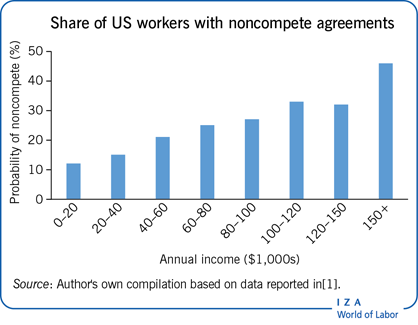Elevator pitch
Labor market institutions that may weaken workers’ bargaining leverage have received increased scrutiny in recent years. One example is noncompete agreements, which prevent workers from freely moving across employers, potentially weakening earnings growth. New data sources and empirical evidence have led policymakers to consider sharp restrictions on their use, especially among lower-income workers. These restrictions take many different forms, each of which has unique tradeoffs between the desire to protect workers while allowing firms to use noncompetes in cases where they may create social value.
Key findings
Pros
Noncompete agreements can promote investments in intangible assets, such as research or worker training, that potentially benefit both employers and workers.
Empirical evidence supports the theory that noncompetes increase worker training and overall rates of corporate investment.
Noncompete agreements can help employers screen out job applicants who are more inclined to job-hop, reducing turnover and overall hiring costs.
Cons
By restricting workers’ ability to change employers, noncompete agreements can shift bargaining power away from workers and hinder wage growth.
Most empirical studies show that the use and enforceability of noncompetes decrease wages, on average, with exceptions in some occupations.
Noncompete agreements can create spillover effects on workers and firms that do not sign them, and potentially reduce the overall competitiveness of labor markets.
Evidence suggests the negative wage impacts of noncompete agreements are disproportionately concentrated on more vulnerable and lower-income workers, including minorities and women.
